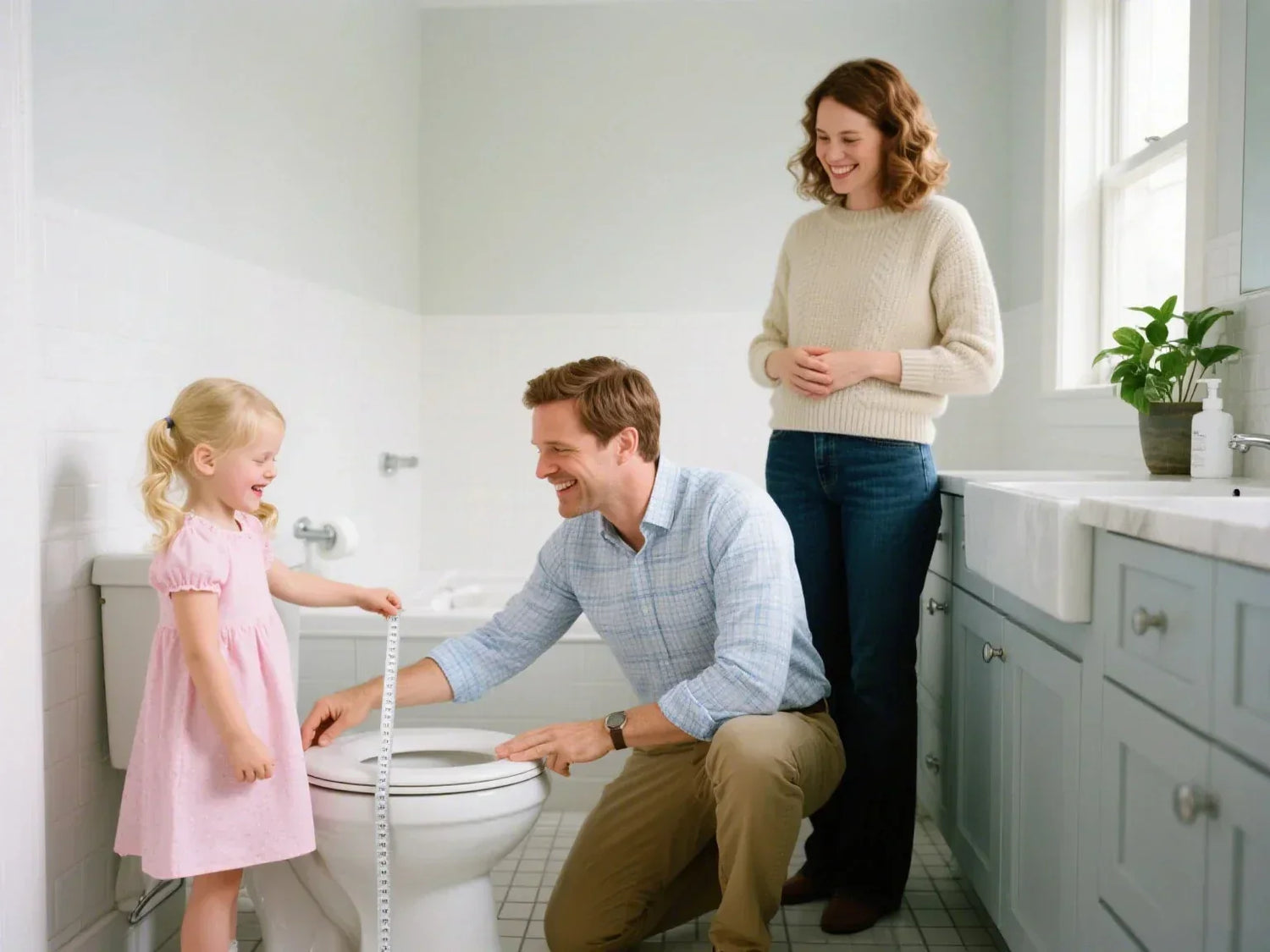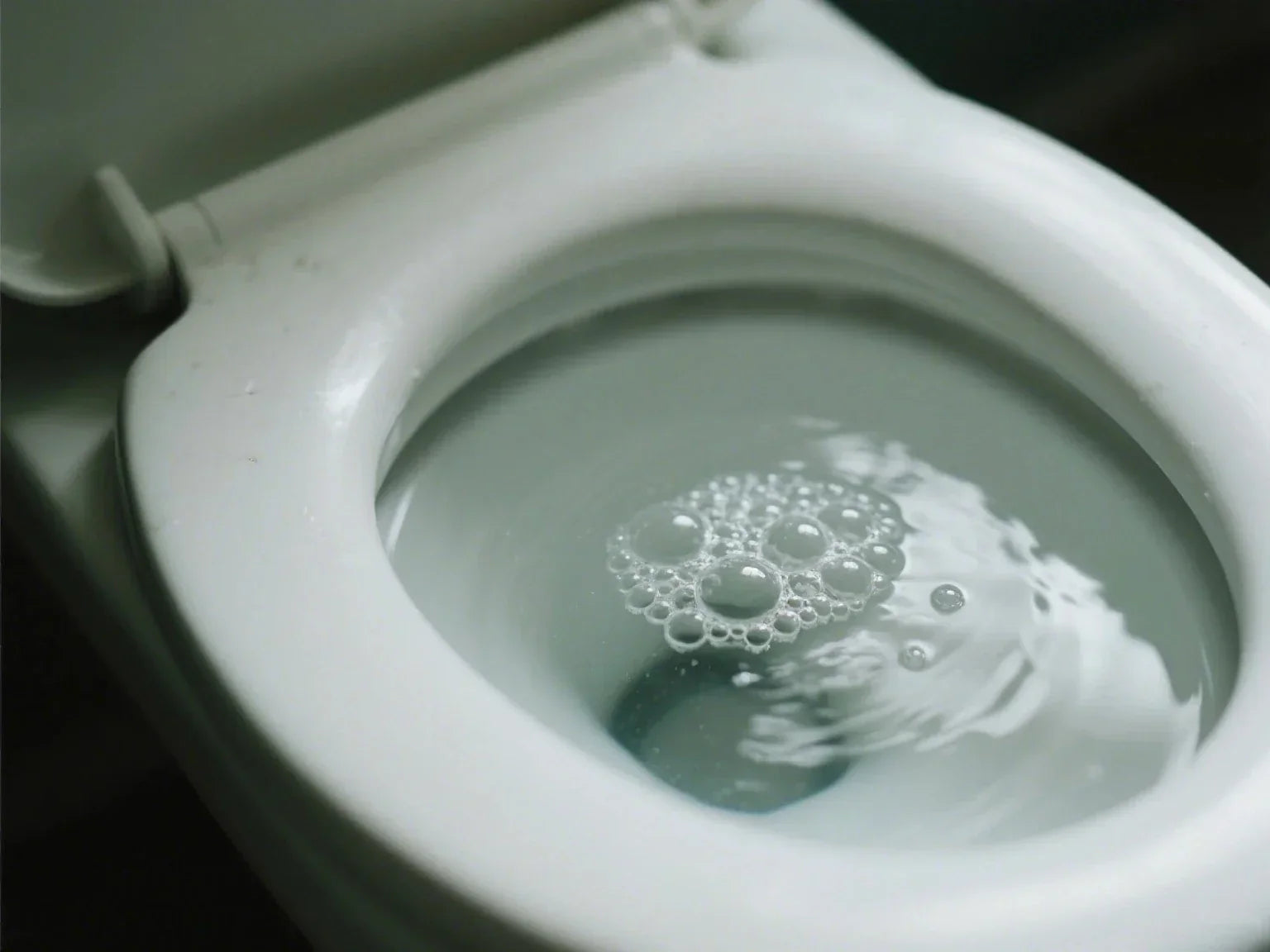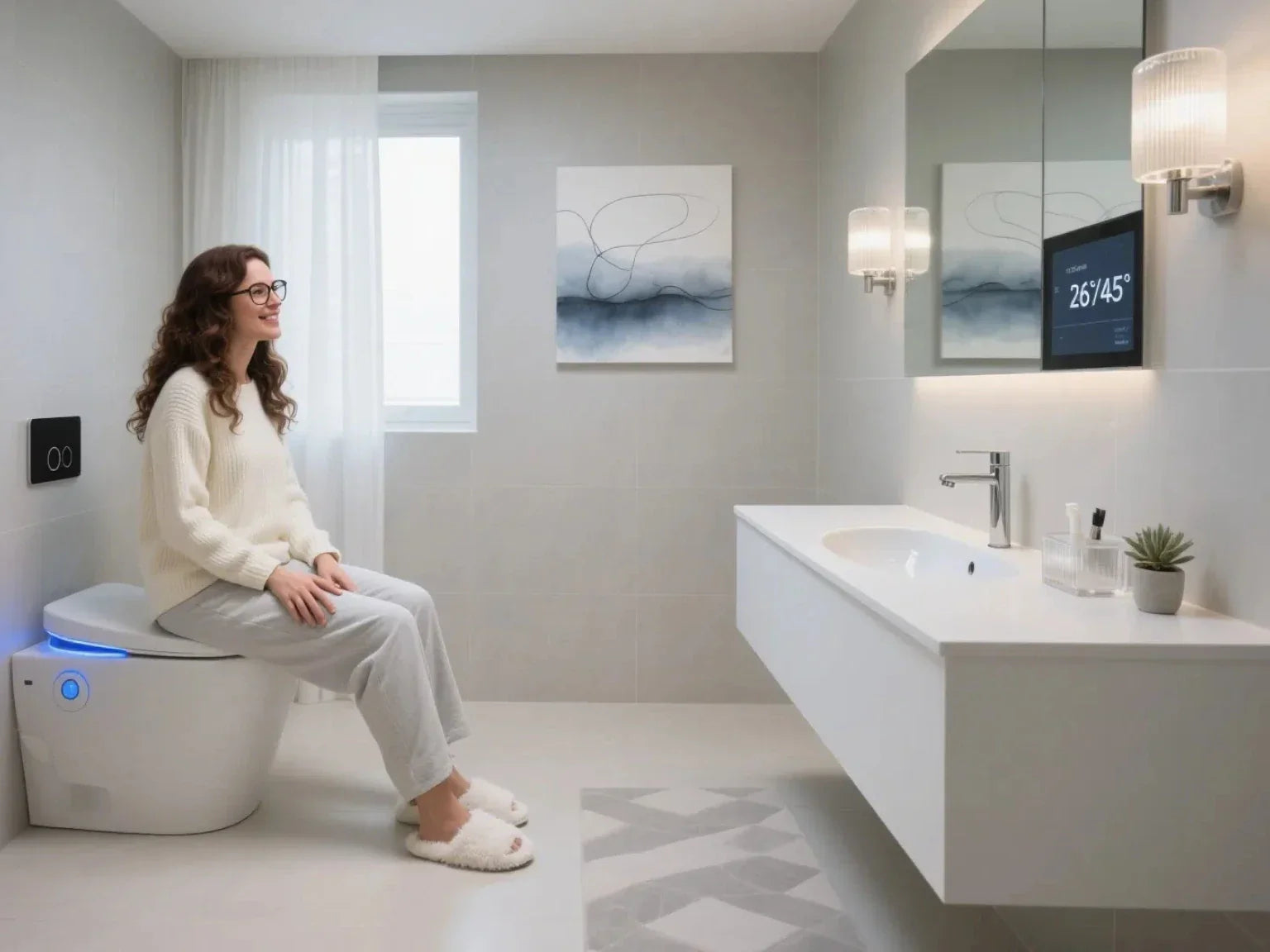When it comes to replacing a new toilet seat, finding the right one can feel surprisingly confusing if you don’t know how to measure a toilet seat accurately. Are toilet seats universal? With a tape measure and a few simple steps, you can make sure your toilet seat replacement fits perfectly, whether your bowl is round, elongated, or something less common. This guide will walk you through every step of how to measure a toilet seat, including trouble-shooting, visual tools, and a handy calculator for a perfect fit.
How to Measure a Toilet Seat—Fast, Accurate Steps
Knowing how to measure a toilet seat correctly is the first step to finding the best fit, no matter if you’re shopping for a new seat, upgrading to a smart bidet, or replacing a worn-out cover.
Quick-Start Summary
Three key measurements:
- Bowl Length
- Bowl Width
- Bolt Spread (distance between mounting holes)
Most common results:
- 16.5 inches (42 cm): Round toilet seat
- 18.5 inches (47 cm): Elongated seat
Always double-check with a tape measure before you buy a new toilet seat
Step-by-Step with Diagrams
1.Identify Your Toilet Bowl Shape & Type
If you want to choose the right toilet seat, first take a good look at its shape. Toilets mainly come in two shapes:
- Round: The bowl has a short, almost circular look (approximately 16.5 inches long, compact and suitable for small bathrooms).
- Elongated: The bowl is longer, with an oval front (approximately 18.5 inches long, more comfortable and suitable for large bathrooms)
But there are also others:
- D-shape: Flat at the back, curved in front, for a modern look.
- Square/Oval: Uncommon or designer types requiring custom seats.
- Specialty: Raised seats (for the elderly and those with limited mobility), child seats, and designs for obese individuals that are wider and stronger.
Here is a diagram of different shapes' detailed data for your information:
| Shape | Typical Length | Description | Visual Tip |
|---|---|---|---|
| Round | 16.5" (42 cm) | Short, almost circular | Sides curve evenly |
| Elongated | 18.5" (47 cm) | Longer, oval front | Sticks out 2" farther |
| D-Shape | 17–18.5" | Flat at back, short at front | Looks like letter D |
| Square | 15–18" | Four sides, straight angles | Corners, sharp edges |
| Specialty | Varies | Unique, child, bariatric, raised | Custom appearance |
2. Measurement Instructions (With Diagrams)
You’ll Need: Tape measure, scratch paper, pen/pencil.
A. Bowl Length
- Place the end of your tape at the center between the rear mounting holes (at the back edge of the toilet bowl).
- Run the tape straight down the middle to the tip of the front rim.
- Write down the number to the nearest 1/8 inch or centimetre.
Example: If your length is about 16.5" (42 cm), you likely have a round bowl. If it’s about 18.5" (47 cm), yours is elongated.

B. Bowl Width
- Stretch the tape measure at the widest point across the bowl.
- Usually, standard seats are 14–14.5" (35.5–37 cm) wide.
C. Bolt Spread (Mounting Holes)
- Measure straight across between the center of the two mounting holes at the back.
- The most common bolt spread is 5.5" (14 cm).
- Some international or specialty toilets may differ.
| Measurement | Where to Measure | Common Result | Metric |
| Bowl Length | Center of rear bolt holes ⟶ Rim | 16.5" or 18.5" | 42 or 47 cm |
| Bowl Width | Widest point across top of bowl | 14"–14.5" | 36–37 cm |
| Bolt Spread (seat bolts) | Center to center at hinge holes | 5.5" | 14 cm |
Visual Reference Table (Imperial & Metric)
| Toilet Seat Style | Bowl Length (in/cm) | Width (in/cm) | Bolt Spread (in/cm) |
| Round | 16.5" / 42 | 14" / 36 | 5.5" / 14 |
| Elongated | 18.5" / 47 | 14.5" / 37 | 5.5" / 14 |
| D-Shape | 17–18.5" / 43–47 | 14–15" / 36–38 | 5.5" / 14 |
| Square | 15–18" / 38–46 | 14–16" / 36–41 | Varies |
3.Why measurements are essential:
- It's easy to make mistakes by looking at the appearance alone: a few inches difference between a round and an oval will result in an improper installation.
- special shapes require special seat rings; and bolt positions may not be standard.
4.Key Points
Determine the shape by measurement: measure the length, width and bolt spacing. Don't just look at the appearance, accurate measurement can ensure that it is comfortable, clean and durable.

How to Measure a Toilet Seat: What If My Toilet Isn’t Standard?
Sometimes, your toilet seat measurements don’t match the usual round or elongated. There are many reasons for this. With the right approach, you can definitely find a suitable one. Here's the solution:
- Older toilets: Older toilets, including European and Asian models, may have different seat dimensions, especially regarding bolt spacing and seat size.
- Hidden or "skirted" bolts: Many toilets now have hidden or partially covered bolts, making them difficult to measure.
Troubleshooting Tips:
- Check both length and width: Why is this important? Some toilets have unusual length and width combinations. If both dimensions are unusual, a custom seat will likely be necessary. Measure the length from the mounting hole to the front, and the width at the widest point to determine the exact dimensions.
- Hidden or partially covered bolts: Check the manual, or look for stickers on the water tank or lid, which will likely contain information about the seat and bolts that match your model.
- UK/EU toilets: They often list everything in cm. For older or imported toilets, try measuring in centimeters. Most European and Asian models use metric units, so this is the correct way to measure them
- Bidet/Smart seats: These seats require additional space behind the toilet for accessories, which may hinder installation. Check the bidet specifications to ensure there's enough space for plumbing and accessories. Measure the space behind the toilet and compare it to the seat's specifications.
- Child/toilet training seats and raised/ADA seats: These special seats will fit on regular toilets, but the size and fit will be different. Check the manufacturer's instructions to confirm that the seat matches the size of your toilet. It will definitely be reliable.
- Seats between round and oval: If in doubt, go for the larger oval shape. A longer seat bulges out slightly and is still comfortable to use; but if it is shorter, it may not cover the entire toilet bowl.

Beyond Sizing—Choosing & Installing the Right Toilet Seat
Once you know how to measure a toilet seat and your specific size, what next? It’s about more than just fit!
Seat Materials:
- Plastic: Lightweight, easy to clean, and inexpensive.
- Wood: Durable, attractive, and has a textured feel.
- Soft or Cushioned: More comfortable, especially for the elderly and children.
- Bidet Integration: Make sure it matches the toilet and pay attention to the installation requirements.
Comfort Features: Some people prefer round shapes to save space, while others find oval shapes more comfortable. Choose the one that suits your taste.
Installation:
Remove the Old Seat:
- Remove the bolts: Use a wrench or hand to loosen the fixing bolts. If you encounter rusted ones, spray some WD-40 to lubricate them, which will make it much easier and save you a lot of effort.
- Remove the seat ring: After the bolts are loosened, gently lift the seat ring and clean the dirt underneath. This step is necessary to ensure smooth installation of the new one, and avoid leaving stains that get in the way.
Clean and Install the New Seat:
- Cleaning: Use a non-scratch cleaner to clean the area around the mounting holes and along the edges, ensuring the contact surfaces are clean and secure.
- Align the seat ring: Place the new seat ring over the bolt holes, making sure it fits snugly. This will ensure a secure and comfortable installation. Don't be careless about alignment. If your home has a partially enclosed toilet, or if the bolts are hidden inside, you'll need to follow the manufacturer's instructions. Also, don't forget to check whether you need special tools.
Secure the Bolts:
- When inserting the bolt, make sure it goes through the hole smoothly and is aligned. This will ensure a secure fit when you install it later.
- When tightening, you must apply even force and don't use too much force, otherwise the bolts will easily be damaged, which will be troublesome. After installing it, give it a gentle shake to see if it's stable. If the seat shakes, adjust it immediately; don't delay, otherwise it will be unstable when used.
Care and Maintenance:
- Check frequently to see if the seat ring is loose. Pay more attention to it so that you can find problems in time and use it with confidence. This is especially important when the elderly and children are around. Tighten the bolts every quarter to prevent the seat ring from loosening and make it more secure to use.
- Cleaning: Just use a mild detergent and a soft cloth to wipe it. Never use strong alkali or rough tools, as it will damage the surface. Wooden seats need special care products so that they can always be in good condition, pleasing to the eye and comfortable to use.
- Replace it promptly: If the seat is cracked or shakes violently, it must be replaced immediately without any delay.

Community Q&A and Expert Troubleshooting
Have a tricky situation? Submit your question!
"My bowl measures 17.2", which seat do I need?"
Pick the elongated model, since it's closer to 18.5" and round is likely too short.
"My toilet has three holes but the new seat only uses two."
Use the outer pair, ignore the center.
"Can I add a bidet seat to my regular toilet?"
Most bidet seats fit standard elongated or round bowls, but check bolt spread and clearance.
Expert Interviews and Stories:
- Some home repair experts recommend always taking a spare photo of your old seat and its measurements to the store—a lifesaver when memory fails.
- Raised or adaptive seats may require extra-long bolts or spacers. Always check the packaging for included parts or seek guidance from supplier helplines.
Conclusion & Fast Takeaways
So, how do you measure a toilet seat? It’s simple:
- Measure from the center of the bolt holes to the very front edge of the toilet bowl — this is your most critical measurement.
- Check the width—should fall between 14" (36 cm) and 14.5" (37 cm).
- Confirm bolt hole spread—almost always 5.5" (14 cm).
| Bowl Shape | Measured Length | Buy This Seat |
| Round | 16.5" / 42 cm | Round |
| Elongated | 18.5" / 47 cm | Elongated |
| Other | Off standard | D-shape/specialty |
It’s always best to measure, write it down or snap a photo, and "shop by number." This ensures comfort, hygiene, and a quick, right-the-first-time upgrade.
Call to Action: Use our toilet seat calculator or printable worksheet to measure your toilet seat accurately—then shop confidently. No more guessing or buying the wrong size!
Measuring a Toilet Seat—FAQs, Common Mistakes & Fixes
What if my measurements are "in-between" standard sizes?
It's normal to find sizes between the standard sizes, such as a toilet seat length of 17 to 17.75 inches, which is common with older or imported toilets. It is recommended to choose the closest standard size, preferably within 0.25 inches (0.6 cm). Slightly longer sizes can be installed, and the slight bulge at the front is less problematic. If it is too short, the porcelain surface will be exposed, which will make sitting uncomfortable and may also be unhygienic.
Some manufacturers will produce "intermediate sizes" or "universal sizes". Choosing one with adjustable size or reading the product description carefully can also help. If you're not sure, take the dimensions and a photo of the toilet to a hardware store and ask for advice, or just contact the manufacturer directly.
Do all toilet seats fit any toilet?
No, toilet seats aren't universal. Most North American home toilets fit round or elongated shapes, but some require special sizing. Even with standard shapes, bolt spacing, profiles, and dimensions vary between brands and models. Wall-mounted and one-piece models may use specialized mounting systems and are incompatible with standard models.
Be sure to measure the size of your toilet seat before purchasing a new one, and check the brand and model number (usually on the inside of the tank lid). Many are universally compatible, but specialized or high-end models may not be compatible.
Should I measure with the old seat on or off?
The most accurate way to measure it is to remove the old seat ring. You can directly measure the length, width, and bolt spacing, and you can also find hidden bolts and other details that may affect installation.
If the bolts are difficult to remove, use an old race to measure: starting from the visible mounting holes, use a flashlight to see the bolt spacing. Try to straighten the old seat as much as possible. Use a tape measure along the curve for a more accurate measurement and be sure to be accurate when measuring.
What if my toilet has hidden bolts or an odd shape?
It's quite common to see toilets with hidden bolts or unusual shapes these days. If you can't see the bolts, look under the seat ring. Many toilets have snap-on toilet seat covers. For toilets with skirts or closed bases, the fixings are often located at the back or slightly below, so you can touch them. Sometimes you need to remove the seat first, or work under the toilet. If your toilet has a unique shape, measure the dimensions before buying a new seat and check the brand and model so you can find the right accessories.
With the right tools and a little research, these things are actually not difficult. Don't panic when checking, just relax and take your time. If you are unsure, just consult the manual or ask others on the forum.
How many errors are acceptable?
Most styles can be installed with a 1/8 inch (about 0.3 cm) difference in bolt spacing or size, and they will be installed securely and function smoothly. However, different models have different degrees of tolerance. If you don’t want to go through the hassle of returns or exchanges, you need to measure the bolt spacing, total length, and widest point. If you are not sure, try to match it with the old seat, it is okay to bring the old one with you when you buy it. A slight difference is usually acceptable, but it is best to measure accurately, especially with newer or non-standard toilets. Double-checking with a tape measure can save you a lot of trouble.
Why is it needed to double-check?
Checking toilet seat dimensions before purchase may seem like a hassle, but it can help prevent frustrating mistakes. Many people think it is a "standard size", but find out that the length, width or shape is wrong. For example, they often confuse circles and ovals, and even if they are slightly off, it is uncomfortable to use. It’s not reliable to depend on your eyes alone, especially for today's toilets, which have smooth lines, skirts, and various customized styles. The internet is filled with examples of people returning or even having to re-drill due to incorrect dimensions.
Taking a minute to measure the bolt spacing and the length and width of the seat ring, and then comparing them with the specifications of the new seat ring, can greatly reduce the possibility of errors. This simple step can save you a lot of time, effort, and money. In short, trust your tape measure, not your eyes.








Leave a comment
This site is protected by hCaptcha and the hCaptcha Privacy Policy and Terms of Service apply.